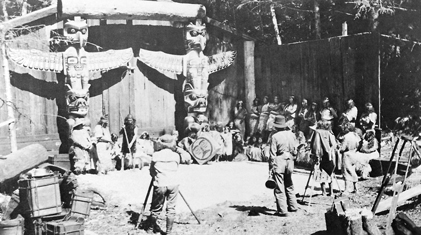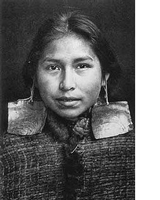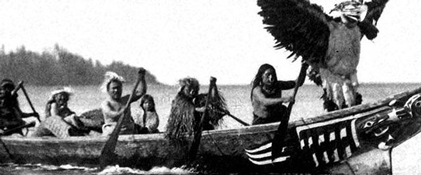Reviewed by Glenn Erickson
Just as 19th century explorers and ethnological anthropologists employed still photography in their work, early filmmakers tried to record the customs of primitive peoples using the new motion picture cameras. To fund his studies of the Indian tribes of Vancouver Island, photographer Edward S. Curtis decided around 1911 to make a commercial motion picture. At that time any unusual subject could draw an audience, and American Indians were a big source of interest, both in the states and in Europe.
Equally unusual were 'documentary' films that could be called authentic. Many were just faked, with the hills around Hollywood standing in for the far North or Africa. Curtis's heavily researched film used a fictional story, but was made on the correct locations with indigenous actors of the Kwakwaka'wakw tribe. Curtis's assistant on was his interpreter George Hunt, an Indian. It was the first film produced with a Native American cast, preceding the famous Nanook of the North by several years.

In the Land of the Head Hunters is a fiction tale that nevertheless serves as an authentic record of tribal ways. Curtis and George Hunt made up the story to frame the ethnological activities Curtis wanted to record. The production was unusual in other ways as well. Curtis paid the Kwakwaka'wakw actors as well as the native craftsmen that constructed the props and buildings needed for the show. Canadian anti- Potlatch laws had suppressed some native customs, including ritual dances, with the idea of eliminating 'wasteful' Indian practices without economic benefit. Part of the reason Curtis obtained so much cooperation was that his movie allowed the construction of masks and other items that were at the time forbidden. Rather than the expected exploitative film project, Head Hunters is still a source of Native American pride.

Curtis's movie is like an illustrated lecture, with the story divided between title cards and illustrative scenes. Young Motana (Stanley Hunt) discovers his true love Naida (Sarah Constance Smith Hunt, Maggie Frank and Mrs. George Walkus) while on a vision quest. As Naida has been promised to an evil sorcerer, Motana raids Naida's camp in full battle mode and steals her away. The sorcerer's equally evil brother Yaklus (Balutsa) mounts a fierce response, destroying Motana's camp, killing his relatives and stealing Naida back once more. A desperate canoe chase follows.
The love story and battle saga are interrupted frequently for tribal dance scenes, elaborate rituals with just one, two, or a dozen dancers in elaborate costumes. A large wooden head mask figures in the impressive Thunderbird dance. As the dances were banned and the indigenous ways already beginning to fade, the costumes, canoes and other authentic Indian crafts-objects were some of the last constructed by natives that learned their crafts through tradition. For this reason In the Land of the Head Hunters is considered a valuable anthropological record.
The film did not survive intact. Bill Holm and George Quimby released a restored short version re-titled In the Land of the War Canoes in 1973; it's included here on a second disc along with a documentary about the restoration. The discovery of new film material and further research prompted a second restoration around 2011, which was completed and premiered in time for the film's centennial in 2014. A full 22 minutes longer, this more polished version carries the original title and also a recording of the original music score by John J. Braham. More title cards have been added to smooth out continuity, along with still images to stand in for missing scenes.

The Milestone Cinematheque's new extras make possible a better understanding of the picture. Especially welcome are an expert commentary and a documentary in which descendants of the tribal filmmakers watch the picture and offer their observations. The modern tribes-people are impressed by the authenticity of the craftwork, and discuss what aspects of the film look right and which don't. They really like the skilled rowing they see in the war canoes. When cultural traditions are gone, they're gone.
We're told that the family of the Kwakwaka'wakw girl who played the virginal maiden Naida was so strict, that she was only allowed to perform in certain scenes. This accounts for the fact that three different women play Naida over the course of the film.
Curtis' movie is one of the oldest to be given a dedicated music score. Other extras cover the music recording for the feature, and present newer videos of native dances. The new disc producers have also generated English subtitles for the Indian dialogue on the older In the Land of the War Canoes version.
My personal takeaway is that Curtis's In the Land of the Head Hunters? sought simply to record the culture but ended up helping to preserve it. The Potlach ban had begun in the 1880s, and at the time of filming only the eldest Kwakwaka'wakw generation still knew the old customs and arts. 'Benign assimilation' simply erased an entire way of life.

The Milestone Cinematheque's two-disc Blu-ray of In the Land of the Head Hunters is an excellent scan of a film in remarkably good shape -- for an independent documentary from 1914. The older War Canoes version on the second disc has higher contrast and looks much rougher; the longer, newer Head Hunters has a lighter transfer that lets us read the image better. There are the expected dings and jump cuts, but details like the 'dream vision' of Naida appearing in the smoke from Motana's fire hold up very well.
The extra documentaries obviously are high in educational value. The new making-of video has additional appeal in that the descendants watching their grandfathers and grandmothers in the picture give the show a more human appeal - they speak of grandfathers, and uncles. The supplemental items include a happy audio surprise, a lengthy selection of chants and songs recorded long ago on primitive audio equipment.
The new bonus features were produced by Aaron Glass, Brad Evans and the U'mista Cultural Centre, and the disc also credits quite a few other supporters and contributors, individuals and organizations. This release demonstrates a real commitment on the part of Milestone Films' to the general film heritage. A commercial company interested only in profit wouldn't devote what was clearly a great deal of time and effort to assembling this remarkable package.
On a scale of Excellent, Good, Fair, and Poor,
In the Land of the Head Hunters Blu-ray rates:
Movie: Very Interesting
Video: Good for a recovery of a 1914 independent documentary
Sound: Excellent
Supplements: Commentary Track on Head Hunters featuring Bill Holm, Andy Everson, and Aaron Glass; Documents of Encounter: The Head Hunters Reconstruction Project (2014. Video, 38 mins.); Cultural Presentation by the Gwa'wina Dancers. (2008. Color, 83 mins.); In the Land of the War Canoes (1973 feature version by Bill Holm & George Quimby, 44 min.); making-of docu The Image Maker and the Indians (1979. Color, 16 min.), Turning Point Ensemble and the score (2013, Color, 3 min.); Still Gallery courtesy of the University of Washington Burke Museum of Natural History and Culture and Mick Gidley.
Deaf and Hearing-impaired Friendly?
N0; Subtitles not needed on silent films with intertitles, but none on extras.
Packaging: Two Blu-ray discs in keep case
Reviewed: February 24, 2015

Text © Copyright 2015 Glenn Erickson
See more exclusive reviews on the Savant Main Page.
The version of this review on the Savant main site has additional images, footnotes and credits information, and may be updated and annotated with reader input and graphics.
Return to Top of Page
|

